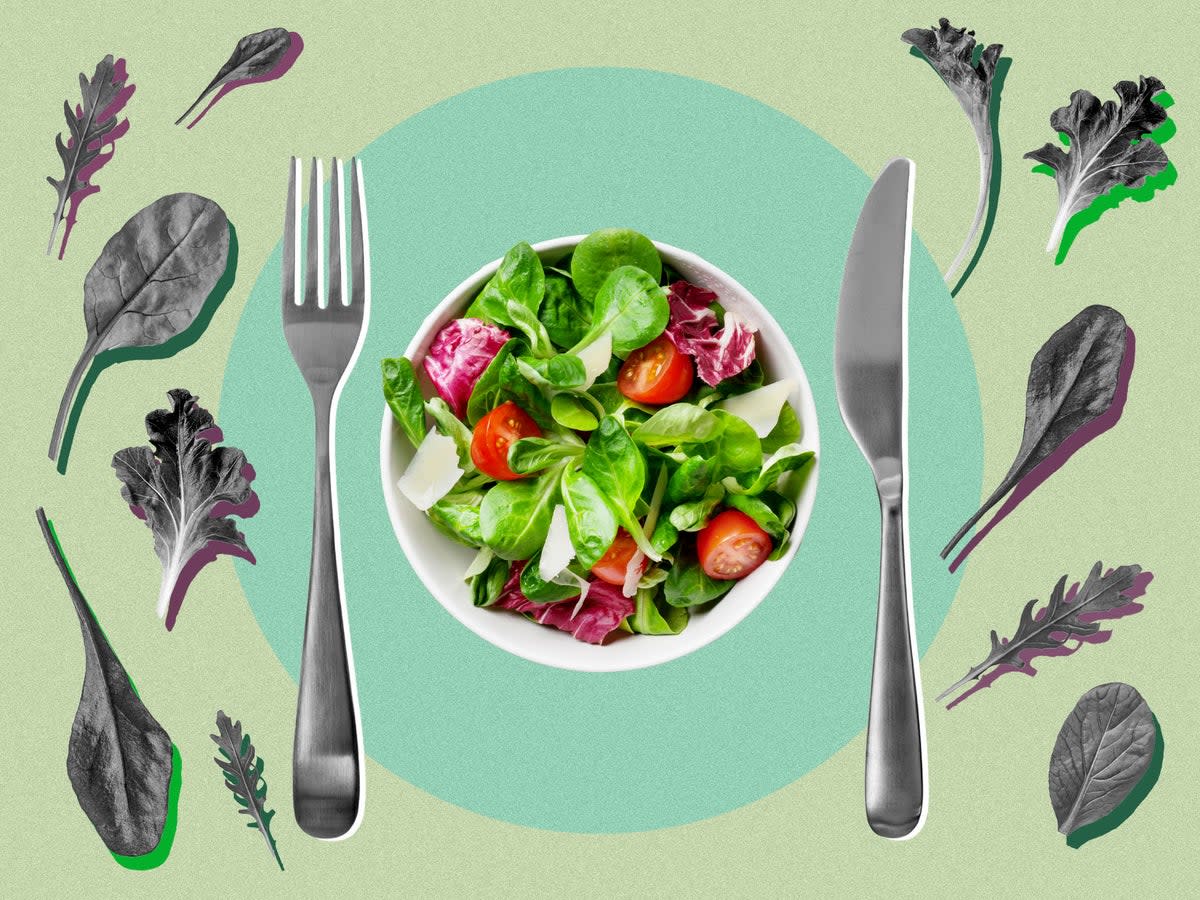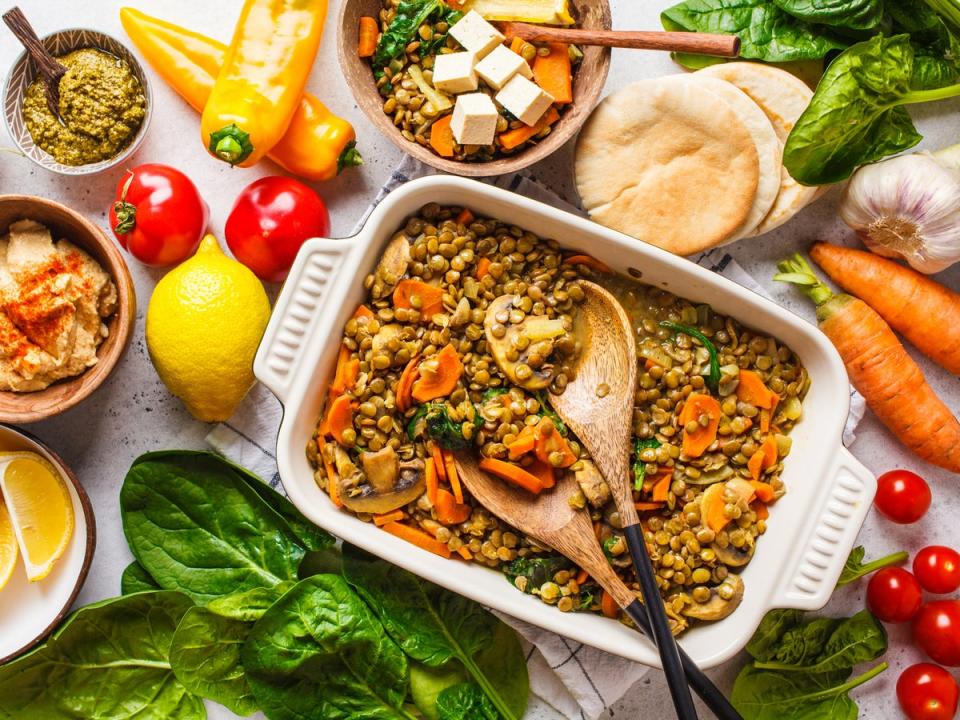Everywhere has a vegan option – so why am I still hungry?

In the wilderness of the London grab-and-go lunchtime race, there was once a widely available wrap in a high street lunch chain that ticked all my boxes: nice, filling and vegan. Its makers still have plenty of decent plant-based options on their menu, so I won’t be naming and shaming them. I miss this particular wrap, though. It had chickpeas for protein, curry sauce to add flavour and fat, and crispy peppers and greens to round it out. But its moment in the sun was brief, and in its place today is a different wrap where hummus is the main ingredient, alongside some veg and shredded carrot. I say this as someone who thinks hummus is the spice of life: hummus is a condiment, not a meal.
There has never been a better time to be a vegan in the UK. We’re long past the point where going vegan over concerns for animals, your health or the planet requires subsisting on falafel and veggie burgers. But at the same time, there are also lots of vegan dishes that have clearly been put on the menu just to tick a box. Dining out can still feel like a roll of the dice: is it going to be a flavourful salad with crispy chickpeas, wild rice, seeds and some incredible mystery dressing, followed by a juicy coconut cake? Or will it be mushroom risotto again, and a sad sorbet?
“There’s still a belief that vegans will just be happy to have any option, and that our tastebuds are not a priority for us,” says Clare Every, who runs The Little London Vegan, a guide to vegan food in the capital. Some restaurants seem to think veganism is a diet. “I do find it annoying when vegans are given lighter alternatives or smaller portions. Like when I ordered a poke bowl the other day – in the vegan version, the rice had been replaced with kale.”
Every says that while things are rapidly getting better, there can still be a lack of care when it comes to catering to vegans. “Veganism is sometimes viewed as a trend or a fad, so chefs may be reluctant to change their ways. There’s still a stigma around veganism and consequently a desire not to cater to [vegan consumers]. Sometimes, there’s even a hatred for them.”
Despite that, there are an increasing number of people eyeing up that vegan menu. Last year, 0.8 per cent of the UK population were vegan, according to a study from the Agriculture and Horticulture Development Board, which also found 5.6 per cent were vegetarian and 16 per cent flexitarian – people, like me, who primarily eat plants with the occasional exception. This means that 22.4 per cent of Britons are on some sort of reduced meat diet, a rise of 2 per cent from the year before.
So far, though, that hasn’t resulted in a wide selection of vegan choices on the high street. Feeling actually satiated is even rarer. “If you just swap everything out with vegetables, you might feel full right after you’ve eaten, but within an hour or two you’re going to be hungry again,” says Romy, the mononymous author and vegan food blogger behind Romy London. Vegans quickly work out that you may need to take slightly bigger portions when omitting meat, but simply eating a whole head of cabbage isn’t going to do it – you need protein.
There needs to be a culture change in chef training where plant protein becomes part of the syllabus
“There are so many great vegan proteins, but I don’t see omnivore places use them enough,” Romy says. At home, vegans may reach for surprisingly cheap proteins like lentils, peas, beans, nuts, seeds, buckwheat and quinoa, creating meals that can look very different to the vegan dishes in omnivore restaurants. For example, I recently learned how to make tofu bacon, and it’s revolutionised my sandwich game. But this incredibly versatile protein is hardly ever spotted outside of vegetarian or East Asian restaurants.
“I think tofu has, like, bad mojo?” Romy laughs. “A plain block of tofu may be overwhelming if you don’t know what to do with it.” Tofu isn’t part of the traditional British diet, meaning chefs may simply not think to reach for it. But increasingly, vegan dinners are saved by mock meats. They’re heavily processed, but the advent of adventurously named plant meats – “soyrizo”, “tuno”, “impossible” burgers and “no cluck” chicken – has certainly revolutionised vegan supermarket sandwiches, and made it easier for chefs looking for more straightforward swaps for familiar ingredients.
Andrea Rymer, a dietitian at the Vegan Society, says that creating a nutritious vegan meal is the same as creating any other: “There needs to be a balance of macronutrients, including carbohydrates and protein. But many restaurants use vegetables as replacements for meat, like mushrooms or jackfruit, making the meal unbalanced.” The lacking nutrient is often protein, but it can also be iron and zinc. “If eating out often, it can put vegans at risk of nutritional deficiencies.”
Going vegan often means breaking with lifelong food habits and truisms. You may have learnt in school that cheese was a good source of protein, “but many vegan cheeses are based on coconut oil, containing [...] little to no protein,” says Rymer. Equally, protein can be found in unexpected places, such as opting for buckwheat instead of wheat flour, soy instead of oat yoghurt, or swapping in lentil pasta. But thinking differently about ingredients requires a change of focus. “Classical chef training involves a lot of filleting fish and deboning meats, seasoning and cooking these correctly, as well as adding dairy to grains and vegetables for flavour,” says Rymer. “There needs to be a culture change in chef training where plant protein becomes part of the syllabus.”
When I’m booking lunch for a mixed group of meat and plant eaters, a good shout is one of the seven Caravan restaurants across London. Miles Kirby, founder and chef director at Caravan, explains that there are no vegans on their team, but he grew up watching his coeliac mum struggle to eat out. “We constantly ask ourselves, is there enough gluten free on the menu? Is there enough dairy free? Is there enough vegan?”

Asked how he creates dishes, Kirby says it’s about flavour, texture and balance, and being inspired by ingredients and letting them sing. “Right now we’ve got king oyster mushrooms on the menu. The texture is so meaty, so we built the dish around that.” A surprising amount of the Caravan menu is plant-based, to which you can add from a selection of various meats, eggs, halloumi and, now, also crispy tofu. “The tofu flies out the door,” he jokes. Kirby says it’s been a conscious choice to offer proteins as sides. “If you want to have it, you order it. If you don’t want it, then you don’t. It means there’s more freedom.”
Allergens have been at the forefront of restaurateurs’ minds for years, but particularly in the wake of the passing of Natasha’s Law in 2021, which requires food businesses to provide full ingredient lists and allergen information on pre-packaged foods. It’s also benefitted vegans. Simple changes can go a long way to make a menu more inclusive, says Kirby: “Frying in oil rather than butter saves you an entire allergen, and stops you excluding a whole group of people [who avoid dairy] without compromising the dish.”
If you’ve been a vegan for a while, you’ll have figured out how to read a menu and pick something that will be satisfying. I know better than to get the vegan BLT if the bacon has been replaced with mushrooms. At dinner I’ll add a side if I think the main dish looks a little light – chips compensate for a lot.
But an omnivore who’s curious about veganism won’t know any of this, and could end up hungry a few hours later and think this is what it is to be vegan. Romy has certainly heard this: “People have said to me, ‘Oh I was hungry all of the time when I did Veganuary’.”
Every agrees that bad experiences can put people off: “The only way to get non-vegans eating more vegan food consistently is to ensure that the quality and taste are just as good as non-vegan dishes.” I’d love to see more chefs take pride in their vegan options and show us just how innovative plant based food can be – if cauliflower can become vegan fried chicken, what else is possible? There’s plenty of people curious about plant-based foods but it needs to taste good, too. It can’t just be a hummus wrap with some leaves. As the great poet Homer Simpson once said, you don’t win friends with salad.

 Yahoo News
Yahoo News 
